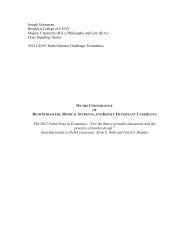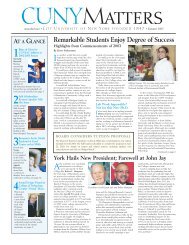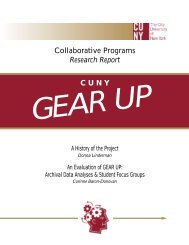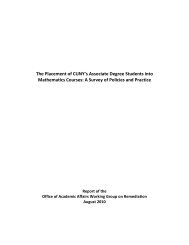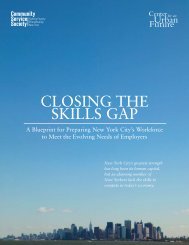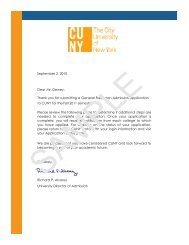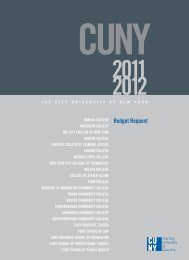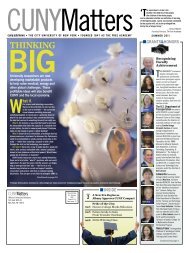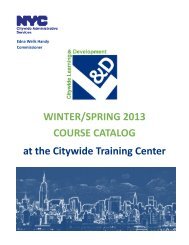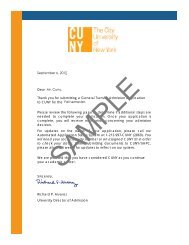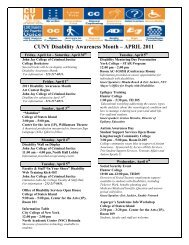CUNY Master Plan 2012-2016
CUNY Master Plan 2012-2016
CUNY Master Plan 2012-2016
Create successful ePaper yourself
Turn your PDF publications into a flip-book with our unique Google optimized e-Paper software.
MISSION PART TWO<br />
successively higher levels as they progress in their studies. The required portion of the Common Core<br />
consists of: English Composition (six credits), Mathematical and Quantitative Reasoning (three credits),<br />
and Life and Physical Sciences (three credits).<br />
The other portion of the Common Core, the Flexible Core, consists of 18 credits: six three-credit liberal<br />
arts and sciences courses with at least one course from each of the following five areas and no more<br />
than two courses in any discipline or interdisciplinary field: World Cultures and Global Issues, U.S. Experience<br />
in its Diversity, Creative Expression, Individual and Society, and the Scientific World.<br />
To ensure the quality of the Common Core across the University, the Pathways resolution passed by<br />
the Board of Trustees in June 2011 specified that the University Office of Academic Affairs, working with<br />
the colleges, “will facilitate the expeditious review and approval of all courses proposed for the Common<br />
Core with the assistance of a <strong>CUNY</strong>-wide committee, appointed by the Chancellor.” To that end, in early<br />
March <strong>2012</strong>, Chancellor Goldstein announced the establishment of the <strong>CUNY</strong> Common Core Course<br />
Review Committee. This committee was charged with the task of reviewing courses submitted by the colleges<br />
to ensure that they meet the designated learning outcomes for the corresponding Common Core<br />
curricular areas. The committee consists entirely of tenured faculty and is divided into eight subcommittees,<br />
one for each area of the Common Core.<br />
Baccalaureate-granting colleges will add six to twelve “College Option” general education credits in<br />
disciplinary or interdisciplinary areas of their own choosing so that graduates with a baccalaureate<br />
degree will complete a total of 36 to 42 credits in general education.<br />
In addition, disciplinary committees have been established, again based on a nominating procedure<br />
including the colleges and the University Faculty Senate, to determine the first three to six courses that<br />
lead into the largest transfer majors. Members of these committees are tenured faculty, very knowledgeable<br />
about curriculum in their areas, and highly regarded within their disciplines and communities. The<br />
President of the Graduate Center is chairing this phase of the initiative.<br />
The Pathways courses will be first offered in fall 2013. By <strong>2016</strong>, the first associate-degree holders who<br />
have taken the entire Pathways Common Core will be transferring to <strong>CUNY</strong> senior colleges. As a result,<br />
by <strong>2016</strong>, <strong>CUNY</strong>’s undergraduate retention and graduation rates should start to increase significantly.<br />
Community Colleges<br />
Community colleges are the fastest-growing sector of higher education; they currently enroll close to<br />
half of all U.S. undergraduates. Much of the enrollment surge at <strong>CUNY</strong> has been at the community college<br />
level, driven in part by the recession, and by the need to update skills and find lower-cost, high-value college<br />
alternatives. Community colleges are a critical pathway for many students seeking baccalaureate<br />
and advanced degrees. Graduation rates at community colleges throughout the nation, though, have long<br />
been disappointing—overall, approximately 22 percent earn degrees within three years and just 16 percent<br />
at large urban schools. President Obama has challenged community colleges to educate an additional<br />
five million students with degrees, certificates, or other credentials by 2020.<br />
A report by the Center for an Urban Future notes that, “[l]ow graduation rates exact steep costs to<br />
51



